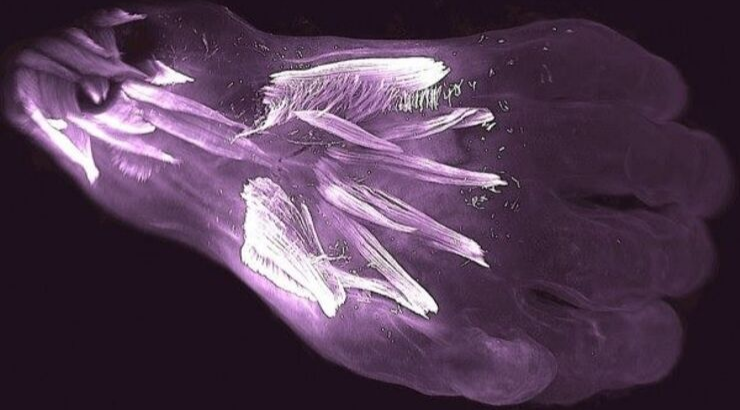(Jake Anderson) A stunning relic recently discovered by biologists may shed light on the transition from reptiles to mammals.
by Jake Anderson, October 6th, 2019
The mystery of human evolution is one of the most vexing questions in science. A stunning physiological relic recently discovered by biologists may shed light on the transition from reptiles to mammals. Scientists believe they have identified a 250 million-year-old lizard-like muscle that very young pre-natal babies develop in their hands and then lose before birth.
The discovery was made after studying 3D medical scans of 15 embryos and fetuses ranging from seven to 13 weeks gestation. Biologists believe the extra dorsometacarpales may help explain humans’ thumb movement, which was an important part of our evolution in the distant past.
Dr. Rui Diogo, who was lead author of the paper written on the finding, says the evolutionary relic can also help explain limb deformities:
“We have a lot of muscles going to the thumb, very precise thumb movements, but we lost a lot of muscles that are going to the other digits.
In our evolution, we do not need them so much.
Why are they there? Probably, we cannot just say in evolution, ‘Look, I will delete from scratch, from day zero, the muscle going to digits two, three, four, five and I will just keep the one going to the thumb.’
Probably it is not so easy. Probably you have to form this layer of this muscle and then it disappears on the other digits but persists on the thumbs.”
Buy Book Phi: A Voyage from the Brain to the Soul
The human body contains other anomalous developmental relics, such as redundant appendix (though there is currently a debate about the true function of this organ), wisdom teeth and coccyx, but Dr. Diogo believes the reptilian leftover is significantly more significant.
“These muscles were lost 250 million years ago,” he said.
“No adult mammal, no rat, no dog has those muscles. It’s impressive. It was really a long time ago.
It used to be that we had more understanding of the early development of fishes, frogs, chicken and mice than in our own species but these new techniques allow us to see human development in much greater detail.”
Buy Book Suppressed Science
The finding raises questions though, such as why we lose such features, which Diogo says allow other mammals to climb with their feet and which could make us “super-humans.”
Anthropologist Dr Sergio Almécija says we must look for other missing parts.
“The important question for me now is, ‘What else are we missing? What will we find when all the human body is inspected at this detail during its development?
What is causing certain structure to disappear and then to appear again? We can now see how it happens but what about the why?”
Stillness in the Storm Editor: Why did we post this?
Science is the pursuit of objective truth. Objective truth is the foundation of philosophic exploration, a critical aspect of personal evolution and the attainment of spiritual values and growth. The preceding information discusses science with regard to development, method, or technique. This is helpful to understand because is a sense everyone is a scientists due to the fact they seek go understand their reality through the powers of observation and modeling. With the power of effective imaging in hand—knowledge acquisition—one can do anything they set their mind to, provided it is possible.
– Justin
Not sure how to make sense of this? Want to learn how to discern like a pro? Read this essential guide to discernment, analysis of claims, and understanding the truth in a world of deception: 4 Key Steps of Discernment – Advanced Truth-Seeking Tools.
Stillness in the Storm Editor’s note: Did you find a spelling error or grammar mistake? Send an email to [email protected], with the error and suggested correction, along with the headline and url. Do you think this article needs an update? Or do you just have some feedback? Send us an email at [email protected]. Thank you for reading.
Source:
https://themindunleashed.com/2019/10/lizard-like-hand-muscles-human-embryos-fetuses.html

Leave a Reply